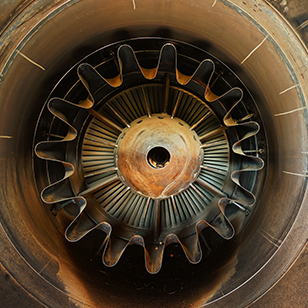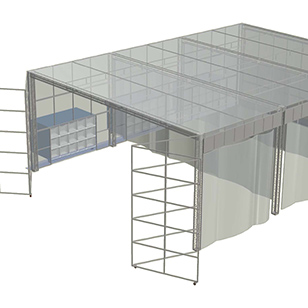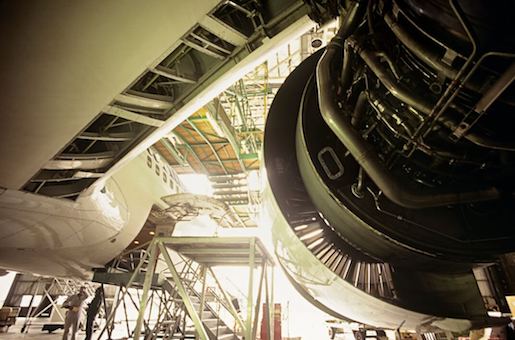5 Ways to Make Your ROI Case for Industrial Air Filtration
You don’t need regulatory watchdogs to tell you that assembly or finishing tasks can pose indoor air quality (IAQ) risks for your manufacturing employees. Welding, sanding, coating and painting tasks can release toxic dust and fumes containing volatile organic compounds (VOCs) that pose serious threats to your workers — and your production schedule.
Don’t wait until you’ve lost valuable hours and productivity to find a clean air solution. Duroair engineers portable, flexible indoor air filtration systems that can isolate and safeguard assembly and finishing tasks, without disrupting your current cellular workflows. What’s more, there are definitive, bottom-line reasons that justify investing in a clean air solution. Here are some examples to take to your boss or stakeholders.
1: Costly Safety Threats
Working with aircraft or military machinery can be particularly hazardous due to hexavalent chromium that is often released into the air during sanding and coating. Hexavalent chromium and other VOCs are unfortunately necessary to make the coatings impervious to salt and moisture.
Aircraft corrosion from salt and moisture is an unacceptable risk for both military operations and commercial aerospace stakeholders. But risking employees to hexavalent chromium exposure is also an unacceptable risk.
According to OSHA, these health risks include:
- Dangers to the skin: Brief skin contact can cause allergic swelling with a red, itchy rash, and repeated skin contact can result in a more severe, longer-lasting dermatitis. Contact with non-intact skin can even lead to chrome ulcers.
- Dangers to the nose and throat: Minor effects may include a runny nose, sneezing, coughing, or itching and burning sensations. Long-term exposure can increase the risk for nosebleeds, sores, or even perforations in the nasal septum (wall separating the nasal passages).
- Dangers to the lungs and stomach: While most people do not develop respiratory tract irritations from airborne hexavalent chromium, some employees can become allergic and develop asthma wheezing and shortness of breath. In extreme cases, workers can develop lung cancer or stomach conditions such as gastritis or gastrointestinal ulcers.
Even more alarming is the fact that unhealthy employees are more prone to making mistakes. Even a small mishap in the hanger or on the shop floor can put mission-critical operations or lives in peril. Additionally, you run the risk of regulatory fines, as OSHA requires all industries to take protective measures to shield their employees from hexavalent chromium exposure, per the Chromium (VI) standard 1910.1026.
2: Downtime & Bottlenecks
Waiting and transport, two of the “deadly wastes” of lean, are often associated with sanding or painting large industrial workpieces, such as an electric turbine or a jet engine. Manufacturers are often forced to transport large pieces by dolly to move them into a separate bay. This type of movement may cause other workflows to temporarily stop, slowing work in progress (WIP).
For space-constrained facilities, all other workflows are often postponed until sanding and painting tasks are completed, further bottlenecking production timelines. Without an indoor clean air solution, manufacturers are often forced to:
- Require all workers not involved with finishing tasks to vacate the facility until the finishing process is complete.
- Air out the hanger or building after sanding, coating or painting, by opening all doors and windows.
- Transport large workpieces to a dedicated area, which requires extensive material handling and man-hours.
- Thoroughly clean areas where sanding and coating took place, to remove particulates before starting a new task.
When time is money, even seemingly simple finishing tasks can become cost-prohibitive without efficient clean air solutions.
3: Operational Equipment Efficiency Risks
If you performed an OEE analysis today would your manufacturing facility make the grade? As noted earlier, airborne particulates from assembly and finishing tasks can cause other workflows to come to a grinding halt. In addition to safety threats, these contaminants can invade every nook and cranny of your valuable machining equipment or settle on recently painted or coated surfaces.
These indoor air OEE killers include:
- CNC machining oil mist that can compromise equipment sensors, circuits, and cooling fans.
- Equipment wear and tear from particles shed from belts and hoses during robotic movement.
- Surface contamination of in-progress industrial workpieces, requiring rework and creating a cascade effect of production bottlenecks.
Even worse, in high enough concentrations, CNC machine dust can become combustible, putting your entire facility at risk.
4: Predictive Maintenance Challenges
If you’re a shop floor or facility manager, you already know that proactive maintenance can prevent unplanned equipment outages, reduce labor costs for repairs, and ensure production efficiency. Predictive maintenance can reduce overall industrial maintenance costs by up to 30%, cut downtime by up to 45% and decrease breakdowns by more than 70%, according to the Department of Energy.
However, excessive maintenance or cleaning (such as HVAC filter changes) can release free-floating contaminants that can contaminate machinery and corrode finishes and paints – threatening quality and reducing your maintenance ROI.
Maintenance tasks that produce airborne hazards include:
- HVAC filter changes: Filter changes dislodge dust, which can short out equipment motors, fuses, and other computer-controlled systems.
- Boiler work: Moving boiler piping often requires welding in areas not designated to control toxic oil mist and weld smoke.
- Facility painting: Even airless spray gun applications can result in overspray and odors/fumes that inhibit productivity.
5: Capital Investment Costs
From an F-16 aircraft wing to a GPS guidance system to a myriad of electronics devices, just a single mission-critical component can cost hundreds of thousands of dollars to manufacture, store, ship, and assemble. As noted earlier, corrosion is a serious threat to components like these, as well as other quality and safety threats resulting from indoor air contaminants.
Duroair’s custom-engineered clean air solutions can help you safeguard your manufacturing processes — and your customers’ significant capital investments — from the tiniest avionics circuitry to the largest cargo jet engines.
Employee safety, operational efficiency and high-value asset protection add up to bottom-line reasons to invest in industrial air filtration. If your operations depend on flexible, cellular manufacturing, Duroair’s modular, multilayer filtration systems can provide flexible, cost-effective, contamination control when and where you need it. Moreover, each of these systems require significantly less capital investment than most facility-wide filtration alternatives


